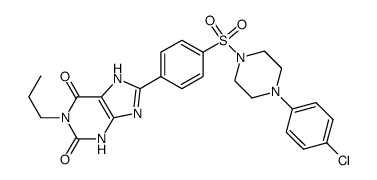1092351-10-4
| Name | 8-(4-(4-(4-chlorophenyl)piperazine-1-sulfonyl)phenyl)-1-propyl-3,7-dihydropurine-2,6-dione |
|---|---|
| Synonyms | BNTX maleate |
| Description | PSB-603 is a potent and selective adenosine A2B receptor antagonist exhibiting a Ki value of 0.553 nM at the human A2B receptor and virtually no affinity for the human and rat A1 and A2A and the human A3 receptors up to a concentration of 10 μM[1]. |
|---|---|
| Related Catalog | |
| In Vitro | PSB-603 inhibits human A2B receptor in Jurkat T cells with an IC50 of 1.13 nM[1]. PSB-603 inhibits human, rat, and mouse A2B receptors with Ki values of 0.553, 0.355, and 0.265 nM, respectively[2]. PSB-603 (100 nM; 24 hours) antagonizes NECA (an adenosine receptor agonist; 1µM) inhibited interferon-γ and stimulated interleukin-6 production[3]. Cell Viability Assay[3] Cell Line: Peripheral T cells Concentration: 100 nM Incubation Time: 24 hours Result: Significantly inhibited NECA stimulated IL-6 release ≈3-fold. |
| In Vivo | PSB-603 shows anti-inflammatory effect in local and systemic inflammation models. PSB-603 (5 mg/kg b.w. ip) significantly reduces inflammation in two mice models of inflammation (local and systemic). PSB-603 significantly decreases levels of the inflammatory cytokines IL-6, TNF-α and of ROS in the inflamed paw and reduces inflammation of the peritoneum by significantly decreasing the infiltration of leukocytes[4]. PSB-603 is administered as suspensions in 1 % Tween 80[4]. Animal Model: Adult male Albino Swiss mice, CD-1, weighing 25-30 g[4] Dosage: 1, 5 or 10 mg/kg Administration: Administered intraperitoneally (ip), prior to carrageenan injection Result: Carrageenan-induced edema model. The increase in paw oedema was significantly inhibited in all groups receiving PSB-603. The dose of 5 mg/kg turned out to be the most active. |
| References |
| Molecular Formula | C24H25ClN6O4S |
|---|---|
| Molecular Weight | 529.01 |
| Exact Mass | 528.13500 |
| PSA | 132.54000 |
| LogP | 3.73790 |
| Hazard Codes | Xi |
|---|
